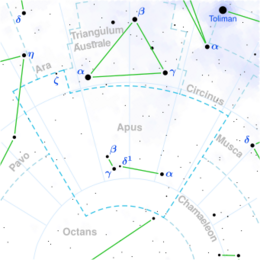Astronomy:HD 138289
| Observation data Epoch J2000.0 Equinox (celestial coordinates) | |
|---|---|
| Constellation | Apus |
| Right ascension | 15h 39m 18.39712s[1] |
| Declination | −77° 55′ 04.8196″[1] |
| Apparent magnitude (V) | 6.18±0.01[2] |
| Characteristics | |
| Evolutionary stage | horizontal branch[3] |
| Spectral type | K2.5 IIIb CN1.5 Ba+0.5[4] |
| U−B color index | +1.36[5] |
| B−V color index | +1.21[5] |
| Astrometry | |
| Radial velocity (Rv) | +13.1[6] km/s |
| Proper motion (μ) | RA: −79.376[1] mas/yr Dec.: −130.969[1] mas/yr |
| Parallax (π) | 9.0832 ± 0.0204[1] mas |
| Distance | 359.1 ± 0.8 ly (110.1 ± 0.2 pc) |
| Absolute magnitude (MV) | +1.21[7] |
| Details | |
| Mass | 1.59[8] M☉ |
| Radius | 13±0.7[9] R☉ |
| Luminosity | 52.5+2.5−2.4[10] L☉ |
| Surface gravity (log g) | 2.71[8] cgs |
| Temperature | 4,672±100[11] K |
| Metallicity [Fe/H] | −0.04[8] dex |
| Rotational velocity (v sin i) | 5.2±4.3[12] km/s |
| Age | 2.78+0.37−0.52[1] Gyr |
| Other designations | |
| Database references | |
| SIMBAD | data |
HD 138289, also known as HR 5757, is a probable spectroscopic binary[12] located in the constellation Apus, the bird-of-paradise. It has an apparent magnitude of 6.18,[2] placing it near the limit for naked eye. Gaia DR3 parallax measurements place the object 359 light years away[1] and it is currently receding with a heliocentric radial velocity of 13.1 km/s.[6] At its current distance, HD 138289's brightness is diminished by 0.25 magnitudes due to extinction from interstellar dust.[14] It has an absolute magnitude of +1.21.[7]
The visible component has a stellar classification of K2.5 IIIb CN1.5 Ba+0.5,[4] indicating that it is a red giant with an anomalous overabundance of cyano radicals in its spectrum. The IIIb luminosity class indicates that it is a lower luminosity giant star. The Ba+0.5 suffix states that it is a mild barium star, whose barium abundance might have come from a hidden white dwarf companion. HD 138289 is estimated to be 2.8 billion years old,[1] enough time for it to cool and expand to 13 times the radius of the Sun.[9] It is now on the horizontal branch,[3] fusing helium at its core. At present it has 1.59 times the mass of the Sun and radiates 52.5 times the luminosity of the Sun[10] from its enlarged photosphere at an effective temperature of 4,672 K.[11] HD 138289 has a near solar metallicity and spins modestly with a poorly constrained projected rotational velocity of 5.2 km/s.[12]
References
- ↑ 1.0 1.1 1.2 1.3 1.4 1.5 1.6 Vallenari, A. et al. (2022). "Gaia Data Release 3. Summary of the content and survey properties". Astronomy & Astrophysics. doi:10.1051/0004-6361/202243940 Gaia DR3 record for this source at VizieR.
- ↑ 2.0 2.1 Høg, E.; Fabricius, C.; Makarov, V. V.; Urban, S.; Corbin, T.; Wycoff, G.; Bastian, U.; Schwekendiek, P. et al. (March 2000). "The Tycho-2 catalogue of the 2.5 million brightest stars". Astronomy and Astrophysics 355: L27–L30. ISSN 0004-6361. Bibcode: 2000A&A...355L..27H.
- ↑ 3.0 3.1 Laney, C. D.; Joner, M. D.; Pietrzyński, G. (11 November 2011). "A new Large Magellanic Cloud K-band distance from precision measurements of nearby red clump stars". Monthly Notices of the Royal Astronomical Society 419 (2): 1637–1641. doi:10.1111/j.1365-2966.2011.19826.x. ISSN 0035-8711. Bibcode: 2012MNRAS.419.1637L.
- ↑ 4.0 4.1 Keenan, Philip C.; McNeil, Raymond C. (October 1989). "The Perkins catalog of revised MK types for the cooler stars". The Astrophysical Journal Supplement Series 71: 245. doi:10.1086/191373. ISSN 0067-0049. Bibcode: 1989ApJS...71..245K.
- ↑ 5.0 5.1 Johnson, H. L.; Mitchell, R. I.; Iriarte, B.; Wisniewski, W. Z. (1966). "UBVRIJKL Photometry of the Bright Stars". Communications of the Lunar and Planetary Laboratory 4: 99–110. Bibcode: 1966CoLPL...4...99J.
- ↑ 6.0 6.1 Evans, David S. (June 20–24, 1966), "The Revision of the General Catalogue of Radial Velocities", in Batten, Alan Henry; Heard, John Frederick, Determination of Radial Velocities and their Applications, Proceedings from IAU Symposium no. 30, 30, University of Toronto: International Astronomical Union, p. 57, Bibcode: 1967IAUS...30...57E
- ↑ 7.0 7.1 Anderson, E.; Francis, Ch. (May 2012). "XHIP: An extended hipparcos compilation". Astronomy Letters 38 (5): 331–346. doi:10.1134/S1063773712050015. ISSN 1063-7737. Bibcode: 2012AstL...38..331A.
- ↑ 8.0 8.1 8.2 Liu, Y. J.; Zhao, G.; Shi, J. R.; Pietrzyński, G.; Gieren, W. (7 November 2007). "The abundances of nearby red clump giants". Monthly Notices of the Royal Astronomical Society 382 (2): 553–566. doi:10.1111/j.1365-2966.2007.11852.x. ISSN 0035-8711. Bibcode: 2007MNRAS.382..553L.
- ↑ 9.0 9.1 Kervella, P.; Thévenin, F.; Di Folco, E.; Ségransan, D. (October 2004). "The angular sizes of dwarf stars and subgiants". Astronomy & Astrophysics 426 (1): 297–307. doi:10.1051/0004-6361:20035930. ISSN 0004-6361. Bibcode: 2004A&A...426..297K.
- ↑ 10.0 10.1 Charbonnel, C.; Lagarde, N.; Jasniewicz, G.; North, P. L.; Shetrone, M.; Krugler Hollek, J.; Smith, V. V.; Smiljanic, R. et al. (January 2020). "Lithium in red giant stars: Constraining non-standard mixing with large surveys in the Gaia era". Astronomy & Astrophysics 633: A34. doi:10.1051/0004-6361/201936360. ISSN 0004-6361. Bibcode: 2020A&A...633A..34C.
- ↑ 11.0 11.1 Stassun, Keivan G. et al. (9 September 2019). "The Revised TESS Input Catalog and Candidate Target List". The Astronomical Journal 158 (4): 138. doi:10.3847/1538-3881/ab3467. Bibcode: 2019AJ....158..138S.
- ↑ 12.0 12.1 12.2 De Medeiros, J. R.; Alves, S.; Udry, S.; Andersen, J.; Nordström, B.; Mayor, M. (January 2014). "A catalog of rotational and radial velocities for evolved stars V: Southern stars". Astronomy & Astrophysics 561: A126. doi:10.1051/0004-6361/201220762. ISSN 0004-6361. Bibcode: 2014A&A...561A.126D.
- ↑ "HD 138289". SIMBAD. Centre de données astronomiques de Strasbourg. http://simbad.u-strasbg.fr/simbad/sim-basic?Ident=HD+138289.
- ↑ Gontcharov, George A.; Mosenkov, Aleksandr V. (28 September 2017). "Verifying reddening and extinction for Gaia DR1 TGAS main sequence stars". Monthly Notices of the Royal Astronomical Society 472 (4): 3805–3820. doi:10.1093/mnras/stx2219. ISSN 0035-8711. Bibcode: 2017MNRAS.472.3805G.
<ref> tag with name "Gould1879" defined in <references> is not used in prior text.
 |


